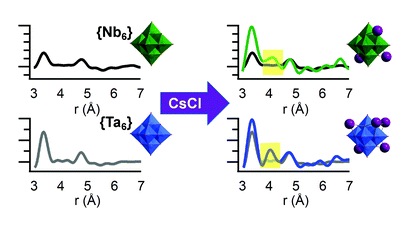Ion pairs and solubility related to ion-pairing in water influence many processes in nature and in synthesis including efficient drug delivery, contaminant transport in the environment, and self-assembly of materials in water. Ion pairs are difficult to observe spectroscopically because they generally do not persist unless extreme solution conditions are applied. Here we demonstrate two advanced techniques coupled with computational studies that quantify the persistence of ion pairs in simple solutions and offer explanations for observed solubility trends. The system of study, ([(CH3)4N]+,Cs)8[M6O19] (M = Nb,Ta), is a set of unique polyoxometalate salts whose water solubility increases with increasing ion-pairing, contrary to most ionic salts. The techniques employed to characterize Cs+ association with [M6O19]8− and related clusters in simple aqueous media are 133Cs NMR (nuclear magnetic resonance) quadrupolar relaxation rate and PDF (pair distribution function) from X-ray scattering. The NMR measurements consistently showed more extensive ion-pairing of Cs+ with the Ta-analogue than the Nb-analogue, although the electrostatics of the ions should be identical. Computational studies also ascertained more persistent Cs+–[Ta6O19] ion pairs than Cs+–[Nb6O19] ion pairs, and bond energy decomposition analyses determined relativistic effects to be the differentiating factor between the two. These distinctions are likely responsible for many of the unexplained differences between aqueous Nb and Ta chemistry, while they are so similar in the solid state. The X-ray scattering studies show atomic level detail of this ion association that has not been prior observed, enabling confidence in our structures for calculations of Cs-cluster association energies. Moreover, detailed NMR studies allow quantification of the number of Cs+ associated with a single [Nb6O19]8− or [Ta6O19]8− anion which agrees with the PDF analyses.
